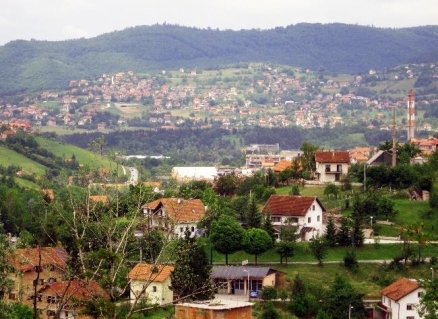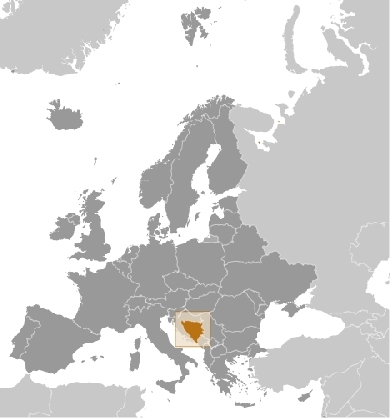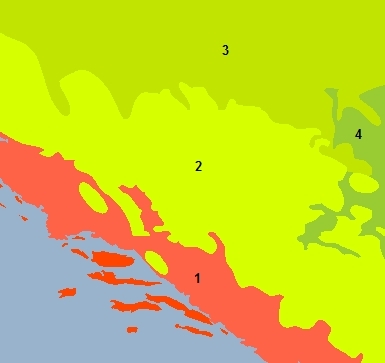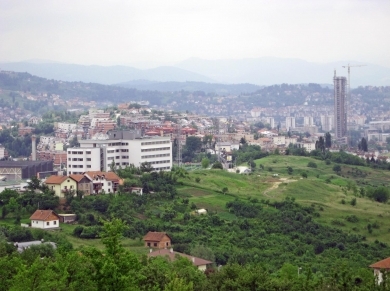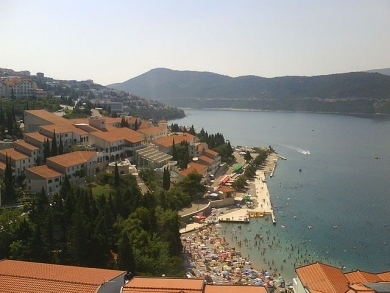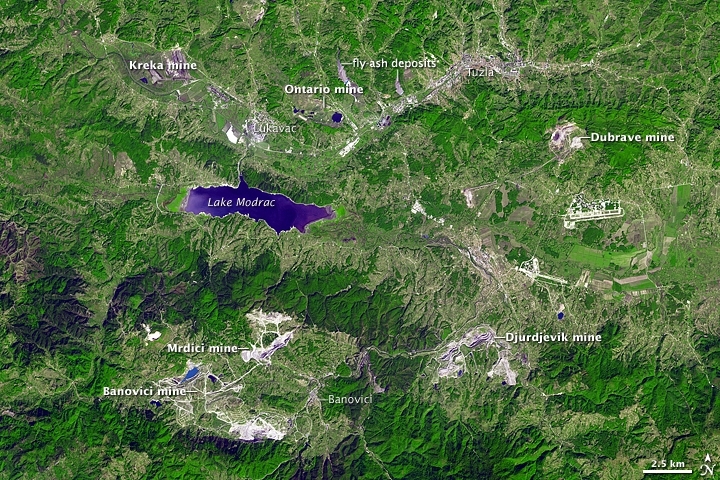Bosnia and Herzegovina
Countries and Regions of the World Collection  Bosnia and Herzegovina is a nation of over four-and-a-half million people in the Baltic region of southeastern Europe, bordering the Adriatic Sea (for just 20 km) and Croatia to the west and north, Montenegro to the south, and Serbia to the east.
Bosnia and Herzegovina is a nation of over four-and-a-half million people in the Baltic region of southeastern Europe, bordering the Adriatic Sea (for just 20 km) and Croatia to the west and north, Montenegro to the south, and Serbia to the east.
Within Bosnia and Herzegovina's recognized borders, the country is divided into a joint Bosniak/Croat Federation (about 51% of the territory) and the Bosnian Serb-led Republika Srpska or RS (about 49% of the territory).
The region called Herzegovina is contiguous to Croatia and Montenegro, and traditionally has been settled by an ethnic Croat majority in the west and an ethnic Serb majority in the east.
Its major environmental issues include: air pollution from metallurgical plants; sites for disposing of urban waste are limited; water shortages and destruction of infrastructure because of the 1992-95 civil strife; and, deforestation. Bosnia and Herzegovina is susceptible to destructive earthquakes.
Bosnia and Herzegovina's declaration of sovereignty in October 1991 was followed by a declaration of independence from the former Yugoslavia on 3 March 1992 after a referendum boycotted by ethnic Serbs.
The Bosnian Serbs - supported by neighboring Serbia and Montenegro - responded with armed resistance aimed at partitioning the republic along ethnic lines and joining Serb-held areas to form a "Greater Serbia." In March 1994, Bosniaks and Croats reduced the number of warring factions from three to two by signing an agreement creating a joint Bosniak/Croat Federation of Bosnia and Herzegovina.
On 21 November 1995, in Dayton, Ohio, the warring parties initialed a peace agreement that brought to a halt three years of interethnic civil strife (the final agreement was signed in Paris on 14 December 1995). The Dayton Peace Accords retained Bosnia and Herzegovina's international boundaries and created a multi-ethnic and democratic government charged with conducting foreign, diplomatic, and fiscal policy. Also recognized was a second tier of government composed of two entities roughly equal in size: the Bosniak/Bosnian Croat Federation of Bosnia and Herzegovina and the Bosnian Serb-led Republika Srpska (RS). The Federation and RS governments were charged with overseeing most government functions. The Dayton Accords also established the Office of the High Representative (OHR) to oversee the implementation of the civilian aspects of the agreement. The Peace Implementation Council (PIC) at its conference in Bonn in 1997 also gave the High Representative the authority to impose legislation and remove officials, the so-called "Bonn Powers." In 1995-96, a NATO-led international peacekeeping force (IFOR) of 60,000 troops served in Bosnia to implement and monitor the military aspects of the agreement. IFOR was succeeded by a smaller, NATO-led Stabilization Force (SFOR) whose mission was to deter renewed hostilities.
European Union peacekeeping troops (EUFOR) replaced SFOR in December 2004; their mission is to maintain peace and stability throughout the country. EUFOR's mission changed from peacekeeping to civil policing in October 2007, with its presence reduced from nearly 7,000 to less than 2,500 troops. Currently EUFOR deploys around 1,300 troops in theater.
Serbia delimited about half of the boundary with Bosnia and Herzegovina, but sections along the Drina River remain in dispute.
Contents
Geography
Location: Southeastern Europe, bordering the Adriatic Sea and Croatia
Geographic Coordinates: 44 00 N, 18 00 E
Area: 51,197 sq km (land: 51,187 sq km; water: 10 sq km)
Land Boundaries: 1,538 km (Croatia 932 km, Montenegro 249 km, Serbia 357 km)
Coastline: 20 km
Natural Hazards: destructive earthquakes.
Terrain: mountains and valleys. The highest point is Maglic (2,386 m)
Climate: hot summers and cold winters; areas of high elevation have short, cool summers and long, severe winters; mild, rainy winters along coast
Ecology and Biodiversity
|
Ecoregions of Bosnia and Herzegovina. Source: World Wildlife Fund |
Illyrian deciduous forests (1 - orange) extend all along the coastal ranges of the Eastern Adriatic coast, from the eastern Alps to the northern Ionian coast between Albania and Greece.
Dinaric Mountains mixed forests(2 - Yellow) encompass the northwest-southeast Balkan mountain ranges, from the eastern Alps to the northern Albania massifs. The ecoregion is covered by mixed forest with an outstanding variety of deciduous oak trees. These forests are among the largest and most continuous tracts of forested habitat remaining for large carnivores in Europe. The flora has a relatively high endemism rate with many relict and restricted range species. Faunal diversity is high, and a number of IBAs (Important Bird Areas) and threatened SPECs (Species of European Concern) are encompassed within the region.
Pannonian mixed forests (3 - lime) covers the depression surrounded by the Carpathian Mountains, Alps, and Dinaric Mountains. Avifauna diversity is high; there are fifty Important Bird Areas in this ecoregion. It covers the norther portion of Bosnia and Herzegovina.
Balkan mixed forests (4 - green) extend into Bosnia and Herzegovina from the east.
|
Sarajevo sprawls over much of its namesake valley's floor.
|
| The famous Stari Most (Old Bridge) in Mostar connects the two parts of the city divided by the Neretva River. Built during the 16th century under Suleiman the Magnificent, the bridge was destroyed in 1993 during the Bosnian War, but was subsequently rebuilt and reopened in 2004. |
| City of Neum on the Adriatic Coast is the only coastal town in Bosnia and Herzegovina. Source: Wikimedia Commons |
People and Society
Population: 4,622,292 (July 2012 est.)
The three constituent peoples of Bosnia and Herzegovina are Bosniaks, Serbs, and Croats, and languages are Bosnian, Serbian, and Croatian. Religions include Islam, Serbian Orthodoxy, Roman Catholicism, Judaism, some Protestant sects, and some others.
Ethnic Groups: Bosniak 48%, Serb 37.1%, Croat 14.3%, other 0.6% (2000) Bosniak has replaced Muslim as an ethnic term in part to avoid confusion with the religious term Muslim - an adherent of Islam.
Age Structure:
0-14 years: 14% (male 333,989/female 313,234)
15-64 years: 71% (male 1,655,669/female 1,625,750)
65 years and over: 15% (male 283,233/female 410,288) (2011 est.)
Population Growth Rate: -0.003% (2012 est.)
Birthrate: 8.89 births/1,000 population (2012 est.)
Death Rate: 8.91 deaths/1,000 population (July 2012 est.)
Net Migration Rate: 0 migrant(s)/1,000 population (2012 est.)
Life Expectancy at Birth: 78.96 years
male: 75.42 years
female: 82.77 years (2012 est.)
Total Fertility Rate: 1.28 children born/woman (2012 est.)
Languages: Bosnian (official), Croatian (official), Serbian
Literacy: (age 15 and over can read and write): 96.7% (2000 est.)
Urbanization: 49% of total population (2010) growing at an annual rate of change of 1.1% (2010-15 est.)
History
For the first centuries of the Christian era, present-day Bosnia was part of the Roman Empire. After the fall of Rome, it was contested by Byzantium and Rome's successors in the west. Slavs settled the region in the 7th century. The medieval kingdom of Bosnia emerged in the 12th century and ended in 1463, when Ottoman Turks conquered the region.
During Ottoman rule, many Bosnians converted from Christianity to Islam. Bosnia was under Ottoman rule until 1878, when the Congress of Berlin transferred administrative control to Austria-Hungary. Austria-Hungary annexed Bosnia in 1908. While those living in Bosnia came under the rule of the Austro-Hungarian Empire, South Slavs in Serbia and elsewhere were calling for a South Slav state. World War I began when Serb nationalist Gavrilo Princip assassinated the Archduke Franz Ferdinand in Sarajevo. Following the Great War, Bosnia became part of the South Slav state of Yugoslavia, only to be given to the Nazi-puppet state, the Independent State of Croatia (NDH) during World War II. Many atrocities were committed against Jews, Serbs, and others who resisted the occupation from 1941-45. The end of the war saw the establishment of a Communist, federal Yugoslavia under wartime leader Josip Broz Tito, with Bosnia and Herzegovina as one of six republics in the Yugoslav federation.
After Tito died in 1980, Yugoslavia's unraveling was hastened by Slobodan Milosevic's rise to power in 1986. Milosevic's embrace of Serb nationalism led to intrastate ethnic strife. Slovenia and Croatia both declared independence from Yugoslavia in June 1991. By late September 1991, Bosnian Serb Radovan Karadzic's Serbian Democratic Party (SDS) had declared four self-proclaimed "Serb Autonomous Regions (SAO)" in Bosnia. In October 1991, the Bosnian Serbs announced the formation within Bosnia of a "Serbian Republic of Bosnia-Herzegovina" that would have its own constitution and parliamentary assembly. In January 1992, Radovan Karadzic publicly proclaimed a fully independent "Republic of the Serbian People in Bosnia-Herzegovina." On March 1, 1992, the Bosnian Government held a referendum on independence. Bosnia's parliament declared the republic's independence on April 5, 1992. However, this move was opposed by Serb representatives, who had voted in their own referendum in November 1991 in favor of remaining in Yugoslavia. Bosnian Serbs, supported by neighboring Serbia, responded with armed force in an effort to partition the republic along ethnic lines. Recognition of Bosnia and Herzegovina's independence by the United States and the European Community occurred on April 6-7, and Bosnia and Herzegovina was admitted to the United Nations on May 22, 1992.
In March 1994, Muslims and Croats in Bosnia signed an agreement creating the Federation of Bosnia and Herzegovina, ending a period of Muslim-Croat conflict. The conflict with the Bosnian Serbs continued through most of 1995. Many atrocities were committed, including acts of genocide committed by members of the Army of Republika Srpska in and around Srebrenica in July 1995, where approximately 8,000 Bosnian Muslim men and boys were killed. The conflict ended with the November 21, 1995 Dayton Peace Agreement, which was formally signed on December 14, 1995 in Paris.
Radovan Karadzic and Ratko Mladic, the political and military leaders of the Bosnian Serbs, were indicted by the International Criminal Tribunal for the Former Yugoslavia in The Hague in July 1995 on charges of genocide and crimes against humanity stemming from their role in crimes against civilians throughout Bosnia and Herzegovina culminating in the Srebrenica massacre. Karadzic was apprehended and transferred to the ICTY in The Hague by Serbian authorities on July 21, 2008. Mladic was apprehended in Serbia on May 26, 2011 and transferred to The Hague on June 1, 2011.
Bosnia and Herzegovina today consists of two Entities--the Federation of Bosnia and Herzegovina (FBiH), which is largely Bosniak and Croat, and the Republika Srpska (RS), which is primarily Serb. In July 2000, the Constitutional Court of Bosnia and Herzegovina rendered a decision whereby Bosniaks, Croats, and Serbs are recognized as constituent peoples throughout the territory of Bosnia and Herzegovina. In March 2002, this decision was formally recognized and agreed on by the major political parties in both Entities.
The most recent national elections took place in October 2010, electing new state presidency members; state, Entity, and cantonal parliaments; and the RS presidency. The BiH presidency was sworn in on November 10, 2010. The RS government was formed in December 2010, and the Federation government was formed in March 2011. The BiH Council of Ministers was formed in February 2012. The next municipal elections are scheduled to occur in 2012, and the next general elections will take place in 2014. In October 2008, Bosnia and Herzegovina held municipal elections, where mayors and members of municipal assemblies were directly elected (in all municipalities except Mostar and Brcko District).
The international community retains an extraordinary civilian and military presence in Bosnia and Herzegovina (BiH) stemming from the Dayton Peace Accords. The Dayton Accords created the position of High Representative, an international official charged with overseeing implementation of the civilian aspects of the agreement. The current High Representative (since March 2009) is Austria's Valentin Inzko (www.ohr.int).
In December 1995, NATO deployed a 60,000-troop Implementation Force (IFOR) to oversee implementation of the military aspects of the peace agreement. IFOR transitioned into a smaller Stabilization Force (SFOR) in 1996. With the end of the SFOR mission in December 2004, the European Union (EU) assumed primary responsibility for military stabilization operations. Approximately 600 EU troops remain deployed in Bosnia (www.euforbih.org). NATO maintains a small headquarters operation with responsibility to assist with defense reform.
Government
Under the provisions of the Dayton Peace Accords, the Entities have competencies in areas such as taxation, except indirect taxation, business development, and general legislation. Entities and cantons control their own budgets, spending on infrastructure, health care, and education. Ongoing reforms have led to the creation of a single, multi-ethnic military under state-level command and control to replace the previous Entity-based institutions and a state-level Indirect Taxation Administration (ITA) that is responsible for the implementation of a nationwide value-added tax (VAT), revenues from which are collected in the "Single Account." The Single Account funds the governments of the state of Bosnia and Herzegovina, the country's foreign debt, the two Entities, and Brcko District. Customs, which had been collected by agencies of the two Entities, also are now collected by a new single state customs service.
Presidency. The Chairmanship of the Presidency in Bosnia and Herzegovina rotates every 8 months among three Presidency members (Bosniak, Serb, Croat), each elected for a 4-year term. The three members of the Presidency are directly elected (the Federation votes for the Bosniak and Croat, and the Republika Srpska for the Serb).
The Chair of the Council of Ministers is nominated by the Presidency and approved by the House of Representatives. He is then responsible for appointing a Foreign Minister, Minister of Defense, Minister of Foreign Trade, and others as appropriate. The Council is responsible for carrying out the policies and decisions in the fields of defense, intelligence, foreign policy; foreign trade policy; customs policy; monetary policy; finances of the institutions and for the international obligations of Bosnia and Herzegovina; immigration, refugee, and asylum policy and regulation; international and inter-Entity criminal law enforcement, including relations with Interpol; establishment and operation of common and international communications facilities; regulation of inter-Entity transportation; air traffic control; facilitation of inter-Entity coordination; and other matters as agreed by the Entities.
Legislature. The Parliamentary Assembly is the lawmaking body in Bosnia and Herzegovina. It consists of two houses: the House of Peoples and the House of Representatives.
The House of Peoples includes 15 delegates, two-thirds of whom come from the Federation (5 Croats and 5 Bosniaks) and one-third from the Republika Srpska (5 Serbs). Nine members of the House of Peoples constitute a quorum, provided that at least three delegates from each ethnic group are present. Federation representatives are selected by the House of Peoples of the Federation, and Republika Srpska representatives are selected by the Republika Srpska National Assembly.
The House of Representatives is composed of 42 members, two-thirds elected from the Federation and one-third elected from the Republika Srpska. Federation representatives are elected directly by the voters of the Federation, and Republika Srpska representatives are directly elected by Republika Srpska voters.
The Parliamentary Assembly is responsible for enacting legislation as necessary to implement decisions of the Presidency or to carry out the responsibilities of the Assembly under the constitution; deciding upon the sources and amounts of revenues for the operations of the institutions of Bosnia and Herzegovina and international obligations of Bosnia and Herzegovina; approving a budget for the institutions of Bosnia and Herzegovina; and deciding whether to consent to the ratification of treaties.
Government Type: emerging federal democratic republic
Capital: Sarajevo (population: 392,000 est. 2009)
Administrative Divisions: 2 first-order administrative divisions and 1 internationally supervised district* - Brcko district (Brcko Distrikt)*, the Bosniak/Croat Federation of Bosnia and Herzegovina (Federacija Bosna i Hercegovina) and the Bosnian Serb-led Republika Srpska; note - Brcko district is in northeastern Bosnia and is a self-governing administrative unit under the sovereignty of Bosnia and Herzegovina and formally held in condominium between the two entities; the District remains under international supervision
Independence Date: 1 March 1992 (from Yugoslavia; referendum for independence completed on 1 March 1992; independence declared on 3 March 1992)
Legal System: civil law system; Constitutional Court review of legislative acts. Bosnia and Herzegovina has not submitted an International Court of Justice (ICJ) jurisdiction declaration but accepts International Criminal Court (ICCt) jurisdiction. Note: the Dayton Peace Accords, signed 14 December 1995 in Paris, included a constitution; but each of the entities also has its own constitution.
Bosnia and Herzegovina has a multi-layered and decentralized judicial system consisting of 14 Justice Ministries and numerous courts. The FBiH has the Constitutional Court of FBiH, the Supreme Court of FBiH, 10 cantonal courts, and municipal courts, as well as minor offense courts. The RS has the Constitutional Court of Republika Srpska, the Supreme Court of Republika Srpska, district courts, and basic courts, as well as minor offense courts. Brcko District also has its own courts.
The Court of Bosnia and Herzegovina (State Court), established by December 8, 2000 legislation, has criminal, administrative, and appeals departments and jurisdiction only over specific types of crimes, such as war crimes, financial crimes (e.g., official corruption and human trafficking), and crimes against the State (e.g., treason and terrorism). Unlike the BiH Constitutional Court, which is the final authority on questions of constitutionality, the State Court operates alongside, not above, the Federation and RS Supreme Courts.
The Constitutional Court of Bosnia and Herzegovina was first established in 1964. It decides any constitutional dispute that arises between the Entities or between Bosnia and Herzegovina and an Entity or Entities. The BiH Constitutional Court also has appellate jurisdiction over issues related to the constitution arising out of a judgment from another court in the country, and jurisdiction over issues referred to it by another court concerning compatibility with the constitution, the European Convention for Human Rights and its associated protocols, laws of BiH, or international law pertinent to a court decision. The BiH Constitutional Court is composed of nine members: four are selected by the House of Representatives of the Federation, two by the Assembly of the Republika Srpska, and three by the President of the European Court of Human Rights after consultation with the Presidency.
International Environmental Agreements
Bosnia and Herzegovina is party to international agreements on Air Pollution, Biodiversity, Climate Change, Climate Change-Kyoto Protocol, Desertification, Hazardous Wastes, Law of the Sea, Marine Life Conservation, Ozone Layer Protection, and Wetlands.
Water
Total Renewable Water Resources: 37.5 cu km (2003)
Freshwater Withdrawal (domestic, industrial, agricultural):
Agriculture
Agricultural products: wheat, corn, fruits, vegetables; livestock
Irrigated Land: 30 sq km (2008)
Resources
Natural Resources: coal, iron ore, bauxite, copper, lead, zinc, chromite, cobalt, manganese, nickel, clay, gypsum, salt, sand, timber, hydropower
Land Use:
Economy
Bosnia and Herzegovina was among the poorer areas of the old Yugoslav Federation and remains one of the poorer countries in Europe.
The interethnic warfare in Bosnia and Herzegovina caused production to plummet by 80% from 1992 to 1995 and unemployment to soar. With an uneasy peace in place, output recovered in 1996-99 at high percentage rates from a low base; but output growth slowed in 2000-02. Part of the lag in output was made up during 2003-08, when GDP growth exceeded 5% per year. However, the country experienced a decline in GDP of nearly 3% in 2009 reflecting local effects of the global economic crisis.
For the most part, agriculture remains in private hands, but farms have been small and inefficient, and net food imports increased dramatically in the aftermath of the 1992-1995 war.
Many industries are still overstaffed, reflecting the legacy of the centrally-planned economy, though limited privatization has improved efficiency in certain sectors. Under Tito, military industries were widespread in Bosnia, which hosted a large share of Yugoslavia's defense plants. During the war, 3 years of interethnic strife damaged or destroyed much of the economy and infrastructure in Bosnia, caused the death of about 100,000 people, and displaced half of the population.
Considerable progress has been made since peace was reestablished following the Dayton Accords. Still regarded as a transition economy, Bosnia and Herzegovina (BiH) sees the long-term goal of EU membership as a driver to further economic growth and development. Due to Bosnia and Herzegovina's strict currency board regime, which links the Konvertibilna Marka (BAM or KM) to the Euro, inflation has remained relatively low and, as a result, the BAM is one of the most stable currencies in Southeast Europe. The banking sector has been fully reformed, with a significant inflow of foreign banks (foreign ownership currently stands at 85% of the banking sector) providing businesses with easier access to capital and a better range of banking services. Lending has slowed significantly since 2008.
The economy relies heavily on the export of metals as well as on remittances and foreign aid.
A highly decentralized government hampers economic policy coordination and reform.
One of Bosnia's main economic challenges since the recession began has been to reduce spending on public sector wages and social benefits to meet the IMF's criteria for obtaining funding for budget shortfalls.
Banking reform accelerated in 2001 as all the Communist-era payments bureaus were shut down; foreign banks, primarily from Austria and Italy, now control most of the banking sector. The konvertibilna marka (convertible mark or BAM) - the national currency introduced in 1998 - is pegged to the euro, and confidence in the currency and the banking sector has increased.
Bosnia's private sector is growing, but foreign investment has dropped off sharply since 2007.
Government spending, at roughly 50% of GDP, remains high because of redundant government offices at the state, entity and municipal level. Privatization of state enterprises has been slow, particularly in the Federation where political division between ethnically-based political parties makes agreement on economic policy more difficult.
A sizeable current account deficit and high unemployment rate remain the two most serious macroeconomic problems.
Successful implementation of a value-added tax in 2006 provided a predictable source of revenue for the government and helped rein in gray-market activity. National-level statistics have also improved over time but a large share of economic activity remains unofficial and unrecorded. Bosnia and Herzegovina became a full member of the Central European Free Trade Agreement in September 2007.
Bosnia and Herzegovina's top economic priorities are:
- acceleration of integration into the EU;
- strengthening the fiscal system;
- public administration reform;
- World Trade Organization (WTO) membership; and,
- securing economic growth by fostering a dynamic, competitive private sector.
To date, work on these priorities has been inconsistent. The country has received a substantial amount of foreign assistance and will need to demonstrate its ability to implement its economic reform agenda in order to advance its stated goal of EU accession. In 2009, Bosnia and Herzegovina undertook an International Monetary Fund (IMF) standby arrangement, necessitated by sharply increased social spending and a fiscal crisis precipitated by the global economic downturn. The program aims to reduce recurrent government spending and to strengthen revenue collection. However, disbursement of IMF aid was suspended in 2011 after a parliamentary deadlock left Bosnia without a state-level government.
In 2011, the country continued to recover from a recession caused by the global financial crisis. Unemployment and poverty are high. Ethnic and political stalemate slow reform and discourage investment. Bosnia relies heavily on West Europe for trade and credit.
GDP: (Purchasing Power Parity): $31.72 billion (2011 est.)
GDP: (Official Exchange Rate): $18.3 billion (2011 est.)
GDP- per capita (PPP): 2.2% (2011 est.)
GDP- composition by sector:
agriculture: 10.1%
industry: 25.8%
services: 64.1% (2011 est.)
Industries: steel, coal, iron ore, lead, zinc, manganese, bauxite, aluminum, vehicle assembly, textiles, tobacco products, wooden furniture, ammunition, domestic appliances, oil refining
Currency: Konvertibilna markas (BAM)
Tuzla Valley Coal Mines
The Tuzla Basin in northeastern Bosnia and Herzegovina has been an industrial mainstay in Eastern Europe since the late 1800s. The area is among the largest suppliers of lignite (brown coal) and sub-bituminous coal to several power plants in the region, including Bosnia’s largest (715 MW) steam-electric plant, which is located in the city of Tuzla, and the nearby coke-production plant in the town of Lukavac.
The area’s heavy dependence on coal for industrial and domestic electricity and heating has left its mark on the surrounding landscape. This approximately natural-color image of the area from the Advanced Spaceborne Thermal Emission And Reflection Radiometer (ASTER) on NASA’s Terra satellite from September 21, 2003, shows large-scale surface mines (also called “open pit,” or “strip mines”) in the Kreka-Banovici-Djurdjevik region. Vegetation is green (brighter than it would naturally appear), bare or urbanized land is light purple to gray, and water is purplish-blue.
Several large mines and their associated debris (tailings) are scattered across the image. Four large open pit mines appear in a clockwise arrangement starting southeast of Tuzla: Dubrave, Djurdjevik, Mrdici, and Banovici, all of which produce brown coal. At the upper left corner of the image is the Kreka strip mine, which produces lignite. East of the inactive Ontario Strip Mine, lavender-colored patches are fly-ash deposits—the residue left over from coal burning at the Tuzla power plant.
The transition from underground mines to more profitable large-scale surface mines has led to soil degradation, dramatic changes to terrain, and water and air pollution. Scientists at the University of Tuzla have estimated that open pit mining has degraded at least 20,000 hectares (about 50,000 acres) of land in the country, with the majority of the damage occurring in the Tuzla Basin. Remediating some of the worst pollution hotspots in the Tuzla Basin is part of a new agreement among cities and local industry to make industrial activities in the area more environmentally sustainable. Source: NASA. Credit: Image submitted by Amer Smailbegovic. Interpretation and caption by Amer Smailbegovic, with contributions from Rebecca Lindsey.
